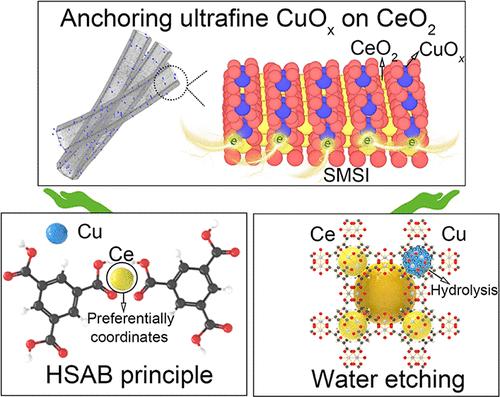通过配位化学在CeO2上界面锚定超细CuOx纳米颗粒以稳定Cu+-Ov-Ce4+活性位点以促进CO优先氧化
IF 8.2
2区 材料科学
Q1 MATERIALS SCIENCE, MULTIDISCIPLINARY
引用次数: 0
摘要
在可还原性氧化物载体上锚定具有精确设计的界面活性位点的超细金属氧化物纳米颗粒的开发已经成为多相催化的一个关键前沿。然而,传统的合成策略难以调和高负载和超细分散,往往导致纳米颗粒聚集和稳定性受损。在此,我们提出了一种结合硬-软酸碱原理和水蚀刻工艺的配位化学驱动策略来合成锚定在CeO2上的超细CuOx纳米颗粒。利用双金属BTC前驱体中Ce3+和Cu2+与羧基配体的差异配位亲和力,实现了溶剂热合成过程中的选择性分离。Ce3+与羧基形成稳定的框架,而Cu2+则通过水解诱导迁移到表面缺陷位点。通过调节Cu2+/Ce3+的比例,可以精确控制CuOx的分散、Cu-O-Ce的界面键合和局部结构。优化后的催化剂铜负载达到21.94%,具有高分散性、高晶格畸变和增强的金属-载体相互作用。值得注意的是,设计的催化剂在富h2流中表现出优异的稳定性,通过亚稳Cu+-Ov-Ce4+活性构型的界面稳定,在40 h内将CO转化率从67.4提高到77.7%。高级表征和密度泛函理论(DFT)计算表明,Cu-O-Ce界面相互作用和不饱和配位CuOx促进了电子转移、氧活化和CO吸附,通过Mars-van Krevelen机制协同提高了催化性能。这项工作为设计具有精确设计活性位点的高性能催化剂建立了合理的配位化学指导范式。本文章由计算机程序翻译,如有差异,请以英文原文为准。

Interfacial Anchoring Ultrafine CuOx Nanoparticles on CeO2 via Coordination Chemistry to Stabilize Cu+-Ov-Ce4+ Active Sites for CO Preferential Oxidation
The development of ultrafine metal oxide nanoparticles anchored on reducible oxide supports with precisely engineered interfacial active sites has emerged as a critical frontier in heterogeneous catalysis. However, conventional synthesis strategies struggle to reconcile high loading with ultrafine dispersion, often leading to nanoparticle aggregation and compromised stability. Herein, we present a coordination chemistry-driven strategy integrating the hard–soft acid–base principle with a water-etching process to synthesize ultrafine CuOx nanoparticles anchored on CeO2. By exploiting the differential coordination affinities of Ce3+ and Cu2+ with carboxyl ligands in a bimetallic BTC precursor, selective segregation during solvothermal synthesis was achieved. Ce3+ formed a stable framework with carboxyl groups, while Cu2+ underwent a hydrolysis-induced migration to surface defect sites. Regulating the Cu2+/Ce3+ ratio enabled precise control over CuOx dispersion, interfacial Cu–O–Ce bonding, and local structure. The optimized catalyst exhibited a remarkable Cu loading of 21.94% with high dispersion, lattice distortion, and enhanced metal–support interactions. Notably, the designed catalyst demonstrated exceptional stability under H2-rich streams, which achieved a CO conversion enhancement from 67.4 to 77.7% over 40 h through the interfacial stabilization of metastable Cu+-Ov-Ce4+ active configurations. Advanced characterization and density functional theory (DFT) calculations revealed that the enhanced interfacial Cu–O–Ce interactions and unsaturated coordinated CuOx species facilitated electron transfer, oxygen activation, and CO adsorption, synergistically boosting the catalytic performance via the Mars–van Krevelen mechanism. This work establishes a rational coordination chemistry-guided paradigm for designing high-performance catalysts with precisely engineered active sites.
求助全文
通过发布文献求助,成功后即可免费获取论文全文。
去求助
来源期刊

ACS Applied Materials & Interfaces
工程技术-材料科学:综合
CiteScore
16.00
自引率
6.30%
发文量
4978
审稿时长
1.8 months
期刊介绍:
ACS Applied Materials & Interfaces is a leading interdisciplinary journal that brings together chemists, engineers, physicists, and biologists to explore the development and utilization of newly-discovered materials and interfacial processes for specific applications. Our journal has experienced remarkable growth since its establishment in 2009, both in terms of the number of articles published and the impact of the research showcased. We are proud to foster a truly global community, with the majority of published articles originating from outside the United States, reflecting the rapid growth of applied research worldwide.
 求助内容:
求助内容: 应助结果提醒方式:
应助结果提醒方式:


